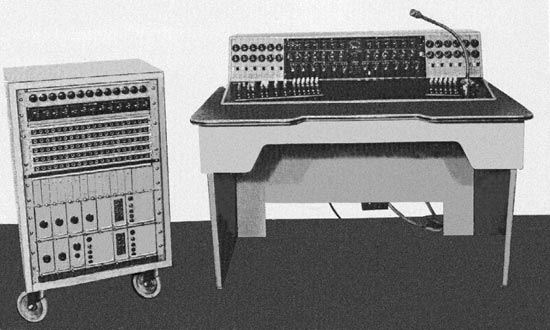
John Longden (better known as Johnny) who worked in London OBs for several years realised that there had to be a better solution to this rather unsatisfactory arrangement. Utilising the recently developed range of transistor amplifiers he set about designing a transportable mixer which could be quickly rigged on site to provide the programme staff with the facilities which they normally associated with studio based programmes. Red and Cue Light switching, rehearsal and transmission talk-back, tone key, echo mixture, PA feeds, PFL and 'White Key' monitoring between Desk Out, off-air Rx, and Tape Repro were among the features available.
Originally, the prototype was used by London OBs but the reputation of what became known as the Longden Music Desk spread rapidly and eventually one set of equipment was made for each of the Regions.
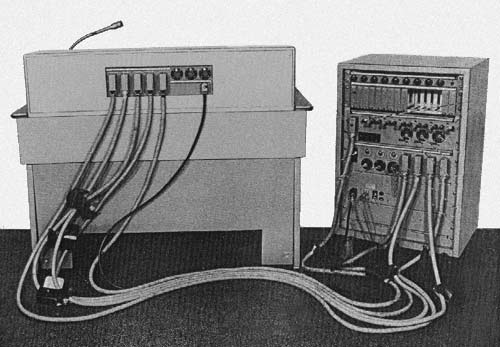
The 3 foot high lightweight aluminium apparatus trolley housed the five-row jackfield, AM9/5 microphone and AM7/5 line sending amplifiers, ME12/4 PPM driver, OS2/15 tone oscillator and PS2/9 power supplies. It was connected to the mixer with five identical multi-pair cables with a 24 way plug at each end making them interchangeable, reversible and hence more easily connected on site. It was decided that fixed sockets on the trolleys would be less vulnerable to damage in transit and with a spare cable carried with the kit an OB would not be jeopardised should an accident befall one of the connecting leads or its connectors. The plugs were protected by specially made leather boots. With an especially long set of connecting cables the trolley could be used at some considerable distance from the mixer if this became operationally necessary without detriment to the audio.
The trolley top was sufficiently strong to bear the weight of a loudspeaker or tape machine and on the rear panel were the five 24 way sockets for connections to the desk unit and a sixth which carried the ten microphone inputs, line terminals for all the programme feeds together with cue and red light sockets. The trolley also housed the echo spring.
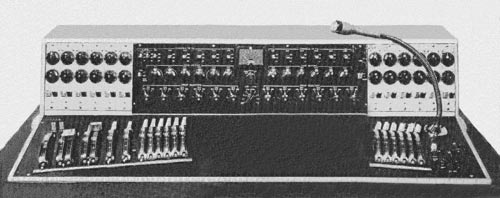
The faders were of the quadrant type, fading up towards the operator with the scale being lit when moved off the back stop, and were totally interchangeable should one go faulty at an OB. As can be seen in the pictures the faders were arranged in two groups on either side of the desk which allowed space for a script between them, something which the Studio Managers had asked for and was thought to be another innovation of the equipment at the time.
Each channel was switchable between microphone matching impedances of 30 or 300 ohms via a transformer or 600 ohm line level inputs. An AM1/4 Response Selection Amplifier (now known as 'eq') was available on each channel together with a PA feed, either pre or post fader. On channel 12 the RSA could be switched into either the incoming mic or echo return circuit. Each channel had an echo mixture switch which fed an echo spring housed in the equipment trolley.
The PPM was selectable between desk out, echo go and the clean feed line. A second three way key selected the LS monitoring between the current PPM selection, a cue or control line and the repro output of a local tape machine for comparing the direct and recorded audio quality. The LS had the normal dim and cut switches and a volume control independent of the loudspeaker's own volume control on its amplifier.
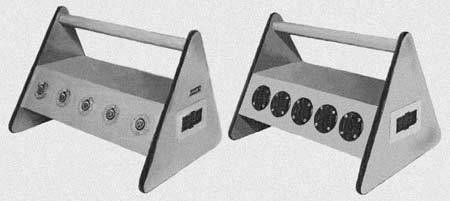
Such was its versatility that the desk could be used for stereo with the main output being the LH channel and the Echo Send as the RH channel and using the echo mixture switches as pan pots! A unique design feature of the equipment was the complete absence of relays which were seen as a potential source of problems, particularly in live situations. Although operated by Ericsson lever keys the mains signal lights were actually switched using a micro switch mounted behind, and actuated by, the lever key mechanism behind the panel!
The lateral thinking shown by John in approaching the technical and ergonomic problems when designing equipment made his designs popular with the users. The build costs were minimal which sometimes made him unpopular with the BBC departments whose task it often was to undertake similar projects but found themselves unable to match the cost.
The equipment was manufactured by the BBC's carpentry workshop in the Langham basement and the CMU (Central Maintenance Unit) mechanical workshop and wiring shop in BH extension.
Johnny Longden went on to build a larger stereo version in 1968 which became known as the 'three piece suite', the mixer consisting of three units with two equipment trolleys. In 1970 he was appointed the first E.i.C. of BBC Radio London, a position he held until his retirement from the BBC in 1982.

I am aware that I got myself into a unique position - the Longden music desks were a clear example of this, and there were many others, such as my first transportable studio desk, known as 'Big Brother' which played a part in the coverage of Princess Margaret's wedding at Westminster Abbey. I believe it was later installed in the Playhouse Theatre studio on the Embankment, after travelling with the Sounds Fantastic show throughout the UK to promote VHF FM radio.
There was a set of small mixers to be used for a special Stockhausen performance for Radio 3, the components all being returned to the stores for later re-use, and earlier, a system of push buttons and lamps devised for One Minute Please, known universally to engineers and producers as 'The Thing'.
I had wonderful support from our own BBC in-house workshops and their skilled tradesmen such as carpenters, metal-bashers and wiremen who had abilities which were largely unrecognised by our own hierarchy.
I longed to set up a 'special projects' sort of commando group of such people, who could work to a scribble on the back of an envelope, rather than wait for fully detailed and expensive drawings, and who could have been awarded higher grades than the standard levels.
In fact, as a 'ghost force' we already existed - though without those special grades! I was able to take some of them on a trip to re-equip the BBC studio in Avenue Hoche in Paris. We built and tested the entirely new studio - table, chairs, and all - in The Langham, then dismantled it, and took it over to France in a BBC pantechnicon provided, with driver, by the transport department. Once safely there, it was unpacked and installed, all this during the Algerian crisis, but that is another story...
I spoke about all this to the then Director General, Sir Ian Trethowan, during my 40th anniversary statutory interview, and he appeared to be favourably surprised, amused, and very interested. He told me how difficult it was from his position to find the right people for the right jobs, and he agreed with me there were many 'villages' of experts beavering away unrecognised within the BBC. He felt it was his job to find and support them, but it was very difficult to do so because it would necessarily involve treading on too many departmental toes.
Related pages
I have no idea how we got away with some of it, but I truly believe it was ultimately to the financial advantage and credit of the BBC that we did. - Johnny Longden.
Bob Smith comments...
John mentioned the bureaucracy of the BBC. Early in our working relationship John told me how for many years he had been obliged to use Painton multi-pinned connectors on his equipment, the same type as the remote connector used on tape machines at the time, whose Pin 1 had an annoying habit of disappearing into its plastic moulding when being plugged in. Not helpful in any situation, particularly when rigging an OB! He desperately wanted to use a connector made by Tuchell but as they were German he was not allowed to use foreign components when an equivalent British item was available.
Then we joined the Common Market and overnight it became permissible to use anything made by a member country! But I do remember that the multi-pair cable he used was, I am fairly sure, German - it being far superior, particularly in respect of its flexibility, to anything available from a British manufacturer at the time. I don't know how he managed it; perhaps its superiority was the key.
One of the Longden desks found its way to the Radiophonic Workshop at Maida Vale in the 1960s. Ray White worked there for many years, fifteen of them as Senior Engineer. He recalls the desk:-
Dave Young, the department's engineer at the time, was responsible for some highly innovative engineering. When the Workshop acquired Room 11 it was fitted out with a Longden desk, complete with its trolley of BBC Type C transistorised plug-in amplifiers. This mixer, with 12 channels, each with a miniature plug-in EQ module, was of an ideal size for the Workshop. However, it was originally equipped with standard quadrant faders, similar in operation to the old BBC rotary faders. These produced 'stud noise', which was especially noticeable on sounds containing pure tones, as produced by the Workshop.
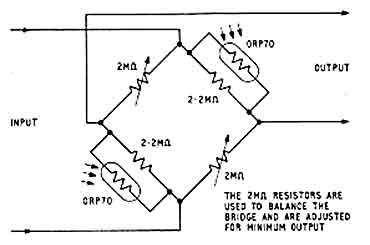
The stud noise was therefore eliminated by the thermal inertia of the light bulbs. This modified fader was known as the 'Glowpot'; therefore the console was known as the Glowpot Desk.
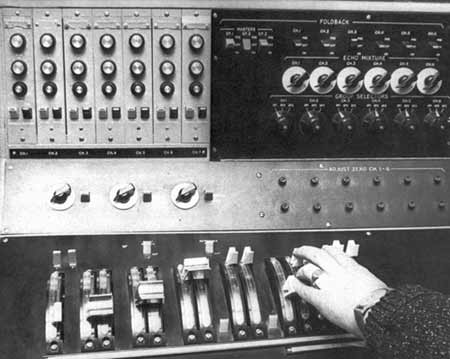
By the late seventies the desk had become inadequate, both in terms of technical quality and facilities, so it was shipped over to BH to be worked on by Technical Services. It eventually returned, looking very impressive with Penny & Giles conductive plastic faders and new electronics throughout. But despite countless weeks of work by the author and Ray Riley it suffered from terrible instability, resulting in constant noises and whistles, giving a performance far worse than the original. A sad example of an 'in house' project going horribly wrong, the product of which eventually made its inevitable journey to Redundant Plant.
Graham Harwood recalls another Longden desk.
We had one of these in Manchester in a van, 852A, bodged for stereo as described above. However at the end of the 70s it was realised that the disparity in signal chains between L and R was introducing an unacceptable phase error and scrapping the desk was proposed. I looked at the drawings and realised that if we made a very small number of changes, e.g. changing the group switches to simple panpots and modifying the constant impedence mixing busses to a simple resistive mix bus, we could employ the group circuitry to feed the Line Send amps giving real stereo and coincidentally freeing the echo chain for its original use. The Group faders became the stereo main fader, and other, now redundant faders and amps were rerouted to give a true independent channel for an announcer and a stereo echo return (line level only, straight into the faders!). A mono line out was also derived, using a hybrid. We also made the original PPM switchable between the M output and Echo Go. All the other monitoring was handled by a Glen stereo monitoring unit.
When the job was done, I was grumbled at by the management for wasting money on a unit that would shortly be scrapped. (The pots cost 80p each and the job took an afternoon!) The desk actually worked for several years afterwards! When it finally became redundant I bought it out, nearly did myself an injury carting it home and subsequently sold it on to St. Mary's, Paddington Hospital Radio. Apparently John Longden was, at the time, their Hon. chief engineer and he subsequently rang me asking if I had drawings of the mods. I was worried that he might not approve of them, but he was apparently quite happy that no fundamental principles had been violated!
Tony Nuttall also remembers the Manchester desk, and the van in which it was installed.
Graham Harwood's notes on his mods to the Longden Desk in 852A brought back happy memories. 852A travelled the length and breadth of the old North Region with Ozy its rigger driver. Its main fault was its top speed of 40 mph. For recordings in Leeds it would always leave at least one and a half hours before the rest of the team to ensure arrival on time. I have such good memories of concerts with Ian Parr, Pip Shepherd, Roy Bradshaw, etc, etc, all SMs and Manchester's Music Producers Earnest Warburton, David Ellis, Stephen Wilkinson, etc - all very happy days!
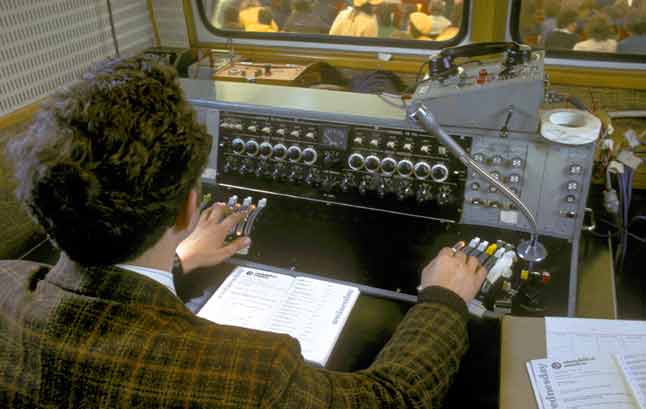
Cardiff's Longden desk is seen in use as the main stage mixer at the Llangollen International Musical Eisteddfod on Wednesday July 3rd 1974. The engineer is Grahame Gambles and the photo is by Geoff Atkins.
Do any of these desks survive? If you know of the whereabouts of one, please get in touch - click here.

